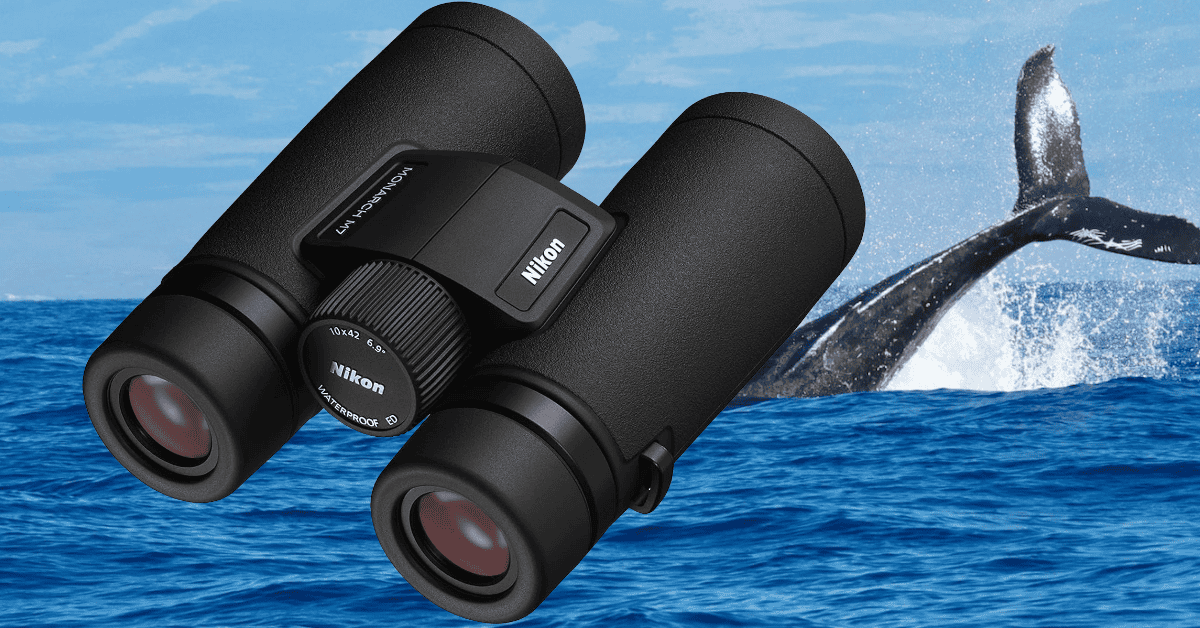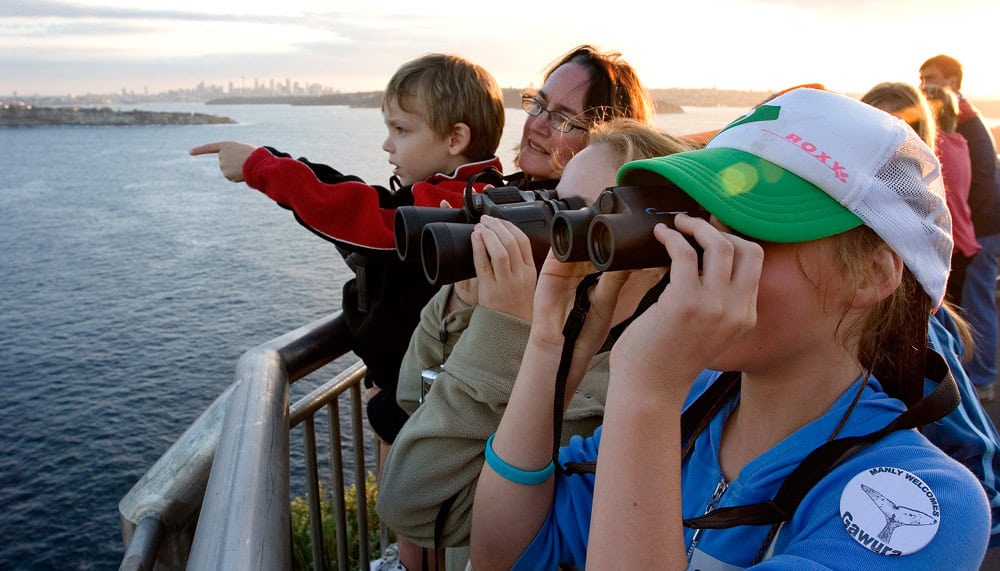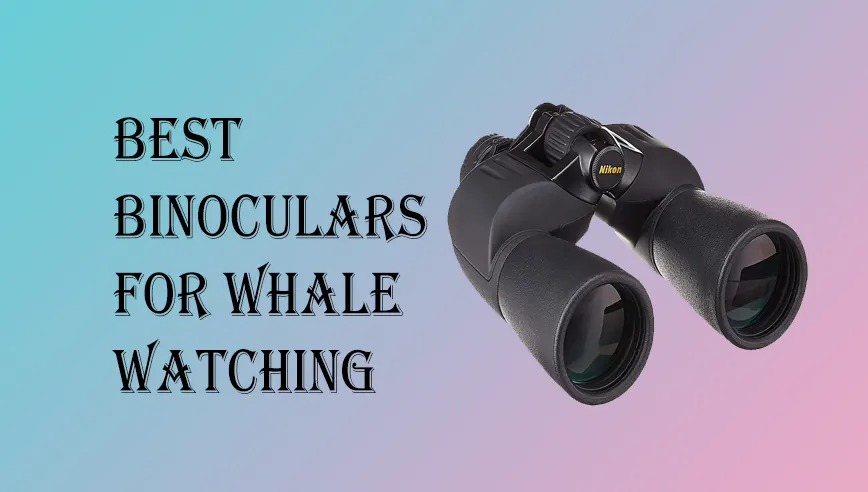Want to choose a binocular for Whale Watching? For whale watching, opt for binoculars with magnification between 7x and 10x, an objective lens diameter of at least 42mm for better light gathering, waterproof and fog-proof construction, and a wide field of view to easily track the movement of whales.
Get Up Close and Personal with Whales: Tips for Selecting the Right Binoculars
Whale watching is an exhilarating and awe-inspiring experience that allows us to witness the beauty and grandeur of these magnificent creatures in their natural habitat. The sight of a massive humpback whale breaching the surface of the water or a pod of dolphins playfully swimming alongside a boat is truly a sight to behold.
To fully appreciate and enjoy these moments, it is essential to have the right equipment, and one of the most important tools for whale watching is a good pair of binoculars.
The Importance of Binoculars in Whale Watching
Binoculars are an essential tool for whale watching as they allow us to get a closer look at these incredible animals without disturbing them or getting too close.
They enhance the experience by bringing distant objects into clear focus, allowing us to observe the intricate details of a whale’s body, such as its flukes or blowholes.
Binoculars also enable us to see behaviors that may not be visible to the naked eye, such as breaching or tail slapping.
Furthermore, binoculars provide a sense of connection with the whales, allowing us to feel more immersed in their world. They bring us closer to the action and make us feel like we are part of the experience.
Without binoculars, we would miss out on many of the subtle nuances and breathtaking moments that make whale watching so special.
Understanding Binocular Specifications: Magnification, Objective Lens Diameter, and Field of View
When choosing binoculars for whale watching, it is important to understand the three main specifications: magnification, objective lens diameter, and field of view.
Magnification refers to how much closer an object appears when viewed through the binoculars compared to the naked eye.
For example, if a pair of binoculars has a magnification of 8x, it means that objects will appear eight times closer than they actually are. Higher magnification can be beneficial for whale watching as it allows for a more detailed view of the whales, but it can also make the image shakier and harder to keep steady.
Objective lens diameter is the second specification to consider. It refers to the size of the front lenses of the binoculars, measured in millimeters.
A larger objective lens diameter allows more light to enter the binoculars, resulting in a brighter image. However, larger lenses also make the binoculars heavier and bulkier, which may not be ideal for long periods of use or when traveling.
Field of view is the third specification to consider. It refers to the width of the area that can be seen through the binoculars at a given distance.
A wider field of view allows for a greater expanse of scenery to be seen, making it easier to locate and track whales as they move through the water. However, a wider field of view often comes at the expense of magnification, so it is important to find a balance that suits your needs.
Types of Binoculars: Roof Prism vs. Porro Prism

There are two main types of binoculars: roof prism and porro prism. The main difference between these two types lies in the way they internally reflect light.
Roof prism binoculars have a straight-through design, with the objective lenses and eyepieces in line with each other. This makes them more compact and lightweight, making them easier to carry and hold for extended periods of time. They also tend to have a narrower field of view compared to porro prism binoculars.
Porro prism binoculars have an offset design, with the objective lenses and eyepieces not in line with each other. This design allows for a wider field of view and often provides better depth perception. Porro prism binoculars are generally larger and heavier than roof prism binoculars, but they often offer better image quality and are more affordable.
When choosing between roof prism and porro prism binoculars for whale watching, it ultimately comes down to personal preference. If portability and ease of use are important factors, then roof prism binoculars may be the better choice. However, if image quality and a wider field of view are more important, then porro prism binoculars may be the better option.
Waterproof and Fogproof Binoculars: A Must-Have for Marine Environments
Whale watching often takes place in marine environments, where the conditions can be harsh and unpredictable. It is essential to have binoculars that are waterproof and fogproof to ensure they can withstand the elements and provide clear views even in challenging conditions.
Waterproof binoculars are sealed with O-rings to prevent water from entering the internal components. This means they can be used in wet conditions, such as during rain or when splashed by waves, without the risk of damage. Waterproof binoculars also tend to be more durable overall, making them a wise investment for outdoor activities.
Fogproof binoculars are filled with nitrogen or argon gas and sealed with O-rings to prevent internal fogging. This is especially important in marine environments where temperature changes can cause condensation inside the binoculars. Fogproof binoculars ensure that the lenses remain clear and free from fog, allowing for uninterrupted viewing even in humid or cold conditions.
Investing in waterproof and fogproof binoculars is crucial for whale watching as it ensures that your equipment will not be damaged by water or fog. It also provides peace of mind knowing that your binoculars will continue to perform optimally regardless of the weather conditions.
Image Stabilization Technology: Keeping Your View Steady
One of the challenges of whale watching is keeping your view steady, especially when observing from a moving boat. This is where image stabilization technology comes in handy.
Image stabilization technology is a feature found in some binoculars that helps to reduce the shakiness of the image caused by hand movements. It works by using gyroscopes or electronic sensors to detect and counteract the movement, resulting in a steadier view.
For whale watching, image stabilization technology can greatly enhance the viewing experience. It allows for a clearer and more stable view of the whales, even when the boat is rocking or when holding the binoculars for extended periods of time. This technology is particularly beneficial for those who may have difficulty holding binoculars steady or for those who want to capture photos or videos of the whales.
When choosing binoculars with image stabilization technology, it is important to consider factors such as battery life and weight. Some models may require batteries to power the stabilization feature, so it is important to ensure that the batteries will last for the duration of your whale watching excursion. Additionally, binoculars with image stabilization technology may be slightly heavier than their non-stabilized counterparts, so it is important to find a balance between stability and comfort.
Choosing the Right Magnification: Balancing Power and Stability
When it comes to choosing the right magnification for whale watching, it is important to strike a balance between power and stability. Higher magnification allows for a closer view of the whales and their behaviors, but it also makes the image shakier and harder to keep steady.
For most whale watching situations, a magnification of 8x or 10x is recommended. These magnifications provide a good balance between power and stability, allowing for a detailed view of the whales without sacrificing too much stability. Higher magnifications, such as 12x or 16x, may provide an even closer view but can be more challenging to keep steady, especially on a moving boat.
It is also worth considering factors such as field of view and depth of field when choosing the right magnification. Higher magnifications often result in a narrower field of view, making it harder to locate and track whales as they move through the water. Additionally, higher magnifications may have a shallower depth of field, meaning that only objects at a specific distance will be in focus while objects closer or farther away may appear blurry.
Objective Lens Diameter: Finding the Right Balance Between Brightness and Portability
Objective lens diameter plays a crucial role in determining the brightness of the image seen through binoculars. A larger objective lens diameter allows more light to enter the binoculars, resulting in a brighter image. However, larger lenses also make the binoculars heavier and bulkier, which may not be ideal for long periods of use or when traveling.
For whale watching, an objective lens diameter of around 42mm is recommended. This size provides a good balance between brightness and portability. Binoculars with larger objective lenses, such as 50mm or 56mm, may offer even brighter images but can be heavier and more cumbersome to carry.
It is important to consider factors such as weight and comfort when choosing the right objective lens diameter. Binoculars that are too heavy or bulky may cause discomfort or fatigue when used for extended periods of time. It is also worth considering whether you will be using a tripod or other support system to stabilize the binoculars, as larger objective lenses may require additional support.
Field of View: How Wide Should Your View Be?
Field of view is an important consideration when choosing binoculars for whale watching. A wider field of view allows for a greater expanse of scenery to be seen, making it easier to locate and track whales as they move through the water. However, a wider field of view often comes at the expense of magnification, so it is important to find a balance that suits your needs.
For whale watching, a field of view of around 300 feet at 1,000 yards is recommended. This provides a good balance between width and magnification, allowing for a wide enough view to spot and track whales while still maintaining a reasonable level of detail.
It is worth noting that the field of view can vary depending on the magnification and design of the binoculars. Higher magnifications often result in a narrower field of view, while certain designs, such as wide-angle or zoom binoculars, may offer wider fields of view. It is important to consider your specific needs and preferences when choosing the right field of view for whale watching.
Ergonomics and Comfort: Selecting Binoculars that Fit Your Hands and Eyes
Ergonomics and comfort are often overlooked factors when choosing binoculars, but they play a crucial role in ensuring an enjoyable whale watching experience. Binoculars that do not fit comfortably in your hands or align properly with your eyes can cause discomfort and fatigue, making it difficult to fully appreciate and enjoy the experience.
When selecting binoculars, it is important to consider factors such as weight, size, and grip. Binoculars that are too heavy or bulky may cause strain on your hands and arms, especially when used for extended periods of time. It is also important to choose binoculars that fit comfortably in your hands, with a grip that feels secure and natural.
Additionally, it is important to ensure that the eyepieces align properly with your eyes. Some binoculars offer adjustable eyecups or eye relief, which allows you to customize the distance between the eyepieces and your eyes. This is particularly important for those who wear glasses, as it ensures that you can see the full field of view without any obstructions.
Conclusion: Investing in Quality Binoculars for a Memorable Whale Watching Experience
In conclusion, having the right equipment is essential for a memorable whale watching experience, and a good pair of binoculars is one of the most important tools to have. Binoculars enhance the experience by bringing distant objects into clear focus, allowing for better observation and a closer connection with the whales.
When choosing binoculars for whale watching, it is important to consider factors such as magnification, objective lens diameter, field of view, and ergonomics. Finding the right balance between power and stability, brightness and portability, and width and magnification is key to selecting binoculars that suit your specific needs and preferences.
Investing in quality binoculars that are waterproof, fogproof, and equipped with image stabilization technology can greatly enhance the whale watching experience. These features ensure that your binoculars can withstand the elements and provide clear views even in challenging conditions.
By investing in the right binoculars and understanding their specifications, you can fully immerse yourself in the thrill of whale watching and create memories that will last a lifetime. So grab your binoculars, head out to the open water, and prepare to be amazed by the beauty and majesty of these incredible creatures.
Originally posted 2024-02-29 09:02:57.




